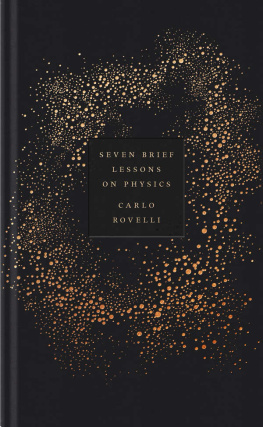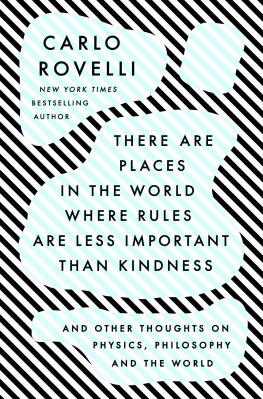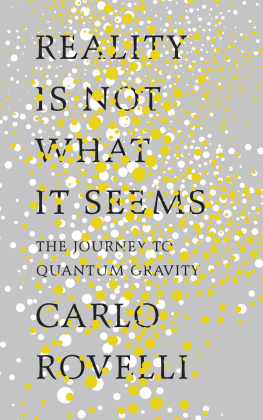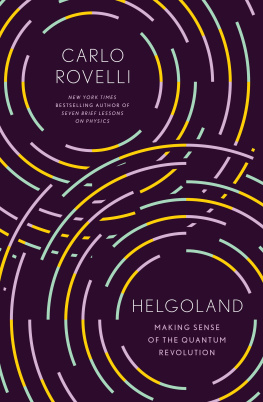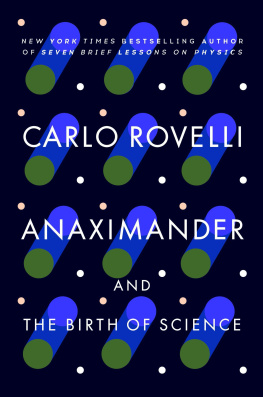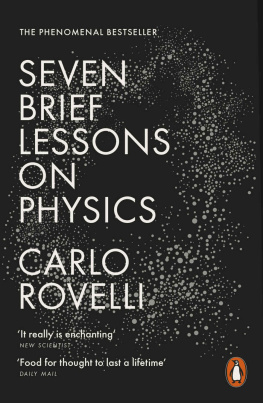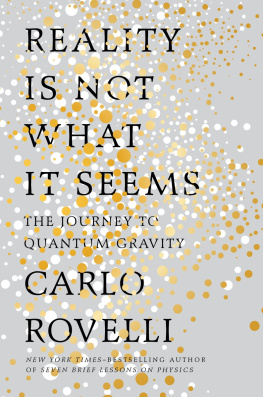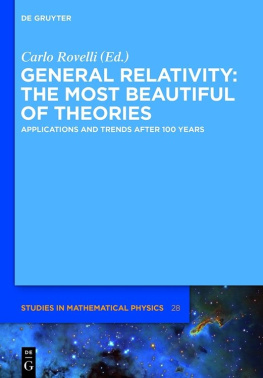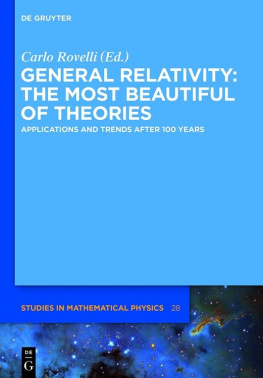Carlo Rovelli
SEVEN BRIEF LESSONS ON PHYSICS
Translated by
Simon Carnell and Erica Segre
Contents
FIRST LESSON:
The Most Beautiful of Theories
SECOND LESSON:
Quanta
THIRD LESSON:
The Architecture of the Cosmos
FOURTH LESSON:
Particles
FIFTH LESSON:
Grains of Space
SIXTH LESSON:
Probability, Time and the Heat of Black Holes
IN CLOSING:
Ourselves
ABOUT THE AUTHOR
Carlo Rovelli is a theoretical physicist who has made significant contributions to the physics of space and time. He has worked in Italy and the US, and is currently directing the quantum gravity research group of the Centre de Physique Thorique in Marseille, France. Seven Brief Lessons on Physics was an instant number one bestseller in Italy and has been translated into twenty-four languages.
Preface
These lessons were written for those who know little or nothing about modern science. Together they provide a rapid overview of the most fascinating aspects of the great revolution that has occurred in physics in the twentieth century, and of the questions and mysteries which this revolution has opened up. Because science shows us how to better understand the world, but it also reveals to us just how vast is the extent of what is still not known.
The first lesson is dedicated to Albert Einsteins general theory of relativity, the most beautiful of theories. The second to quantum mechanics, where the most baffling aspects of modern physics lurk. The third is dedicated to the cosmos: the architecture of the universe which we inhabit; the fourth to its elementary particles. The fifth deals with quantum gravity: the attempts which are underway to construct a synthesis of the major discoveries of the twentieth century. The sixth is on probability and the heat of black holes. The final section of the book returns to ourselves, and asks how it is possible to think about our existence in the light of the strange world described by physics.
The lessons are expansions of a series of articles published by the author in the Sunday supplement of the Italian newspaper Il Sole 24 Ore. I would like to thank in particular Armando Massarenti, who can be credited with opening up the cultural pages of a Sunday paper to science, and allowing light to be thrown on the role of this integral and vital aspect of our culture.
FIRST LESSON
The Most Beautiful of Theories
In his youth Albert Einstein spent a year loafing aimlessly. You dont get anywhere by not wasting time something, unfortunately, which the parents of teenagers tend frequently to forget. He was in Pavia. He had joined his family having abandoned his studies in Germany, unable to endure the rigours of his high school there. It was the beginning of the twentieth century, and in Italy the beginning of its industrial revolution. His father, an engineer, was installing the first electrical power plants in the Paduan plains. Albert was reading Kant and attending occasional lectures at the University of Pavia: for pleasure, without being registered there or having to think about exams. It is thus that serious scientists are made.
After this he registered at the Polytechnic Institute in Zurich, and immersed himself in the study of physics. A few years later, in 1905, he sent three articles to the most prestigious scientific journal of the period, the Annalen der Physik. Each of these is worthy of a Nobel Prize. The first shows that atoms really exist. The second lays the first foundation for quantum mechanics, which I will discuss in the next lesson. The third presents his first theory of relativity (known today as special relativity), the theory which elucidates how time does not pass identically for everyone: two identical twins find that they are different in age, if one of them has travelled at speed.
Einstein became a renowned scientist overnight and received offers of employment from various universities. But something disturbed him: despite its immediate acclaim, his theory of relativity did not fit with what we know about gravity, namely with how things fall. He came to realize this when writing an article summarizing his theory, and began to wonder if the law of universal gravity as formulated by the father of physics himself, Isaac Newton, was in need of revision in order to make it compatible with the new concept of relativity. He immersed himself in the problem. It would take ten years to resolve. Ten years of frenzied study, attempts, errors, confusion, mistaken articles, brilliant ideas, misconceived ideas.
Finally, in November 1915, he committed to print an article giving the complete solution: a new theory of gravity, which he called The General Theory of Relativity, his masterpiece and the most beautiful of theories, according to the great Russian physicist Lev Landau.
There are absolute masterpieces which move us intensely: Mozarts Requiem; Homers Odyssey; the Sistine Chapel; King Lear. To fully appreciate their brilliance may require a long apprenticeship, but the reward is sheer beauty and not only this, but the opening of our eyes to a new perspective upon the world. Einsteins jewel, the general theory of relativity, is a masterpiece of this order.
I remember the excitement I felt when I began to understand something about it. It was summer. I was on a beach at Condofuri in Calabria, immersed in the sunshine of the Hellenic Mediterranean, and in the last year of my university studies. Undistracted by schooling, one studies best during vacations. I was studying with the help of a book that had been gnawed at the edges by mice, because at night Id used it to block the holes of these poor creatures in the rather dilapidated, hippy-ish house on an Umbrian hillside where I used to take refuge from the tedium of university classes in Bologna. Every so often I would raise my eyes from the book and look at the glittering sea: it seemed to me that I was actually seeing the curvature of space and time imagined by Einstein. As if by magic: as if a friend was whispering into my ear an extraordinary hidden truth, suddenly raising the veil of reality to disclose a simpler, deeper order. Ever since we discovered that the Earth is round and turns like a mad spinning-top we have understood that reality is not as it appears to us: every time we glimpse a new aspect of it, it is a deeply emotional experience. Another veil has fallen.
But amongst the numerous leaps forward in our understanding that have succeeded each other over the course of history, Einsteins is perhaps unequalled. Why?
In the first place because, once you understand how it works, the theory has a breathtaking simplicity. Ill summarize the idea.
Newton had tried to explain the reason why things fall and the planets turn. He had imagined the existence of a force which draws all material bodies towards one another, and called it the force of gravity. How this force was exerted between things distant from each other, without there being anything between them, was unknown and the great father of modern science was cautious of offering a hypothesis. Newton had also imagined that bodies moved through space, and that space was a great empty container, a large box which enclosed the universe, an immense structure through which all objects ran true until a force obliged their trajectory to curve. What this space was made of, this container of the world he invented, Newton could not say. But a few years before the birth of Einstein two great British physicists, Michael Faraday and James Maxwell, had added a key ingredient to Newtons cold world: the electromagnetic field. This field is a real entity which, diffused everywhere, carries radio waves, fills space, can vibrate and oscillate like the surface of a lake, and transports the electrical force. Since his youth Einstein had been fascinated by this electromagnetic field which turned the rotors in the power stations built by his father, and he soon came to understand that gravity, like electricity, must be conveyed by a field as well: a gravitational field analogous to the electrical field must exist. He aimed at understanding how this gravitational field worked, and how it could be described with equations.

